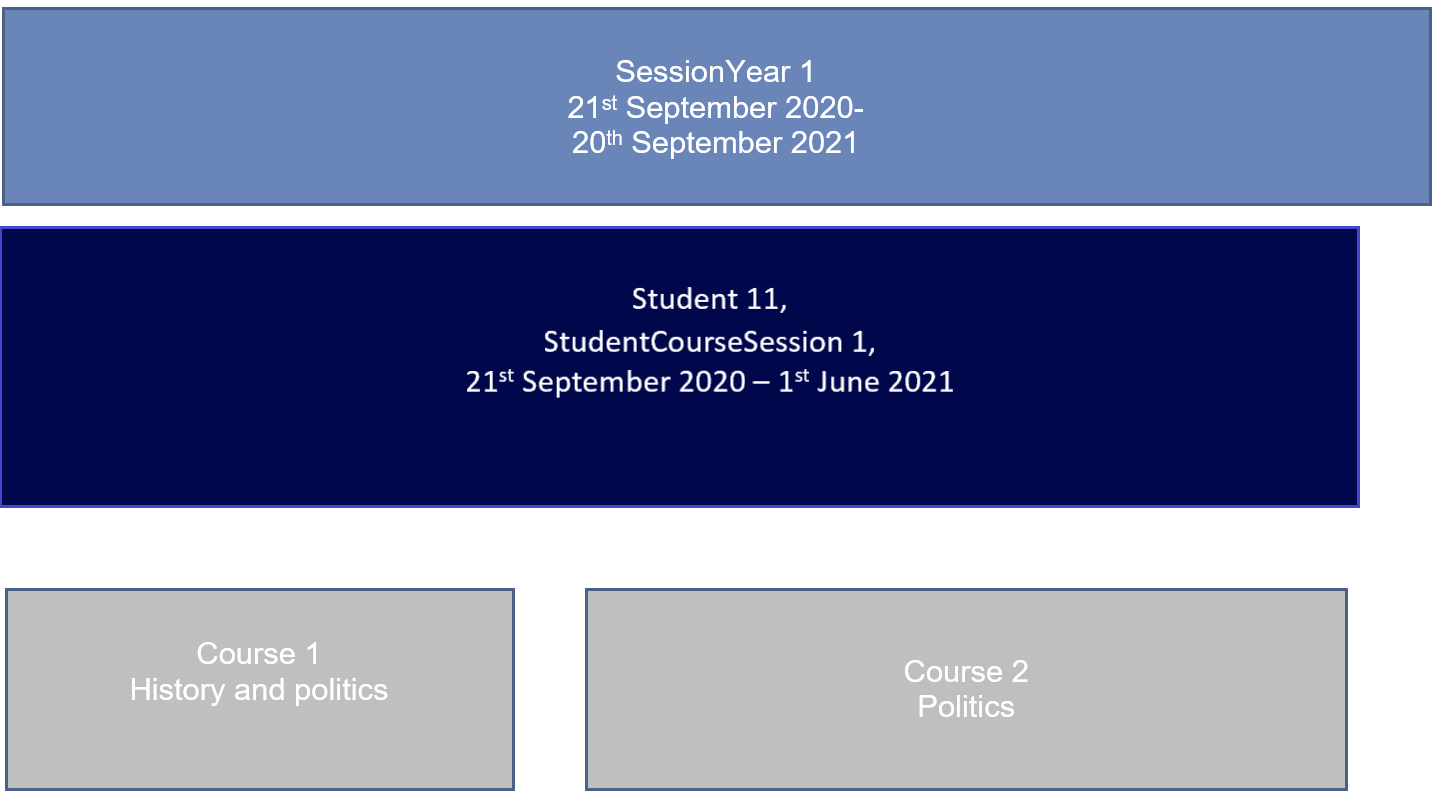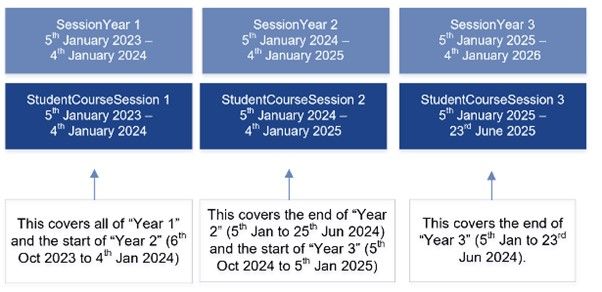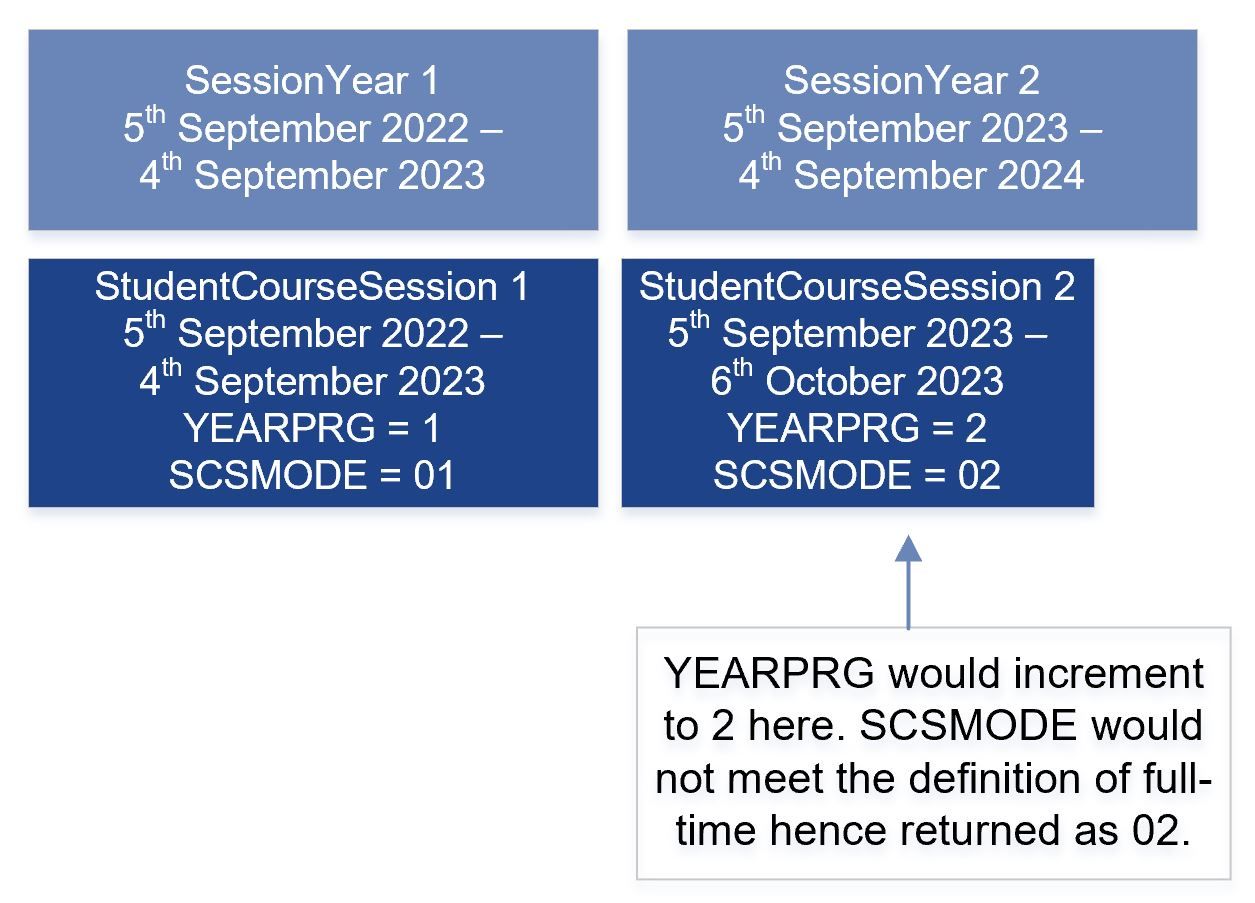Session Years and Student Course Sessions
This document provides general guidance regarding the return of SessionYears and StudentCourseSessions as well as some scenarios for how these would be returned.
General principles
SessionYears:
- In general SessionYears must be 12 months in length. If the course is shorter than a standard year in its entirety or it is a preparatory element of a course, then the provider can chose to return a short SessionYear. A provider may also choose to attach the course to an existing SessionYear.
- The SessionYear records the planned dates for a course year only and so different SessionYears are not required to be returned for different student activity or patterns of study.
SessionYears are not required to be returned for fully flexible, postgraduate research or credit accumulation courses. Credit accumulation is a process of achieving credits over time in relation to a course or courses of study, or formally-recognised experiential learning. Each higher education awarding body determines what credit it will accept for purposes of accumulation or transfer in relation to its individual courses.
Any courses where Qualification.QUALCAT=C0008, D0004, E0003, H0018, I0012, J0011, L0002 or M0022 would not be required to return SessionYears and would instead be returned with year long StudentCoursesSessions. If the student then moves on to study for a qualification and has a different aim, at that point they should be attached to SessionYears.
StudentCourseSessions:
- StudentCourseSessions associate an Engagement with the course the student is studying on and the SessionYear (unless the course is fully flexible or postgraduate research).
- In most cases, a StudentCourseSession records a year of a student’s activity. Examples of where a StudentCourseSession would be less than the student's standard course year would be when the student withdraws from a course or the course length is shorter than a year, as seen in StudentCourseSession scenario 5, or where the student has entered their study with previously awarded credit points or Accreditation of Prior Experiential Learning (APEL).
- The StudentCourseSession dates must record the actual dates that the student was studying on a course year.
- For fully flexible, postgraduate research provision and credit accumulation courses, yearlong StudentCourseSessions are returned starting from the date the student commenced study.
- An Engagement cannot have overlapping StudentCourseSessions.
How SessionYears and StudentCourseSessions work together:
- The SessionYear records 12-month duration/continuance, the StudentCourseSession records the actual dates. So a StudentCourseSession may have different dates to the associated SessionYear if the student starts late or leaves early.
- The StudentCourseSession dates must be contained within the dates of the associated SessionYear.
- If a student moves between different SessionYears, the first StudentCourseSession would be closed, and a new StudentCourseSession returned associated with the new SessionYear and/or course.
- The actual planned start date of the course must be within 14 days from the SessionYear.SYSTARTDATE. As it is the planned start date of the course, it is only expect that there would be a StudentCourseSession.SCSSTARTDATE outside of the 14 days if the student joins the course late (which may include transfers). An exception to this is where a student may enter their study with some previously awarded credit points or Accreditation of Prior Experiential Learning (APEL) and the StudentCourseSession.SCSSTARTDATE could be outside of the 14 days.
- A SessionYear must not exceed one year and four days in length. Where a StudentCourseSession is not linked to a SessionYear (in the case of postgraduate research, fully flexible and credit accumulation courses) the length of the StudentCourseSession must not exceed one year plus four days.
SessionYear scenario 1
A provider offers a number of courses that all start on the 21st September 2020. The courses are across different subjects, modes and types of activity, e.g. with and without a sandwich year.
As all the years of the courses start at the same point, one SessionYear would be required for each year that these courses will run. Each SessionYear will be a year in length.
If the provider offered a number of courses that start within a short space of time, different SessionYears are not required, however the SessionYear.SYSTARTDATE must be within 14 days from the actual planned start date of the course. For example, if the provider offers a course that started on the 25th September, students on this course could be associated with the above SessionYears, rather than new SessionYears being required to be returned.
SessionYear scenario 2
The provider additionally offers one of these courses with entry points in September, January and April.
As the course has different entry points throughout the year, a different SessionYear is required for each start point for each year the course runs. Each SessionYear will be a year long.
SessionYear scenario 3
The provider has a short course that runs for 3 months each summer.
As the course is shorter than a year for its entirety, one 3-month long SessionYear could be returned for each time the course runs.
SessionYear scenario 4
The provider has an 18-month course which starts in October each year.
As the course is longer than a year in its entirety, two SessionYears should be returned and they must be a year in length. One year long SessionYear must be returned in each year the course runs.
This allows students in their first and second years of study to be associated with the same SessionYears (see StudentCourseSession scenario 4).
SessionYear scenario 5
The provider offers a foundation degree to degree bridging course. This lasts for one month before the students move onto the third year of a first degree course.
As this first month is a bridging course, the first SessionYear can last for just the month of the bridging element.
The student can then be associated with the same SessionYear as other students who did not undertake the bridging element (see StudentCourseSession scenario 5).
This only applies where the student’s Engagement starts with a preparatory phase such as a bridging course (StudentCourseSession.PREPFLAG = 01).
StudentCourseSession scenarios
The following scenarios show how StudentCourseSessions would be returned in a number of different circumstances. These use, where applicable, the SessionYears outlined above to show how StudentCourseSessions and SessionYears link together.
StudentCourseSession scenario 1
Student 1 is undertaking a first degree starting on the 21st September 2020.
Their first StudentCourseSession would therefore be returned associated with SessionYear 1.
A number of other students are also undertaking the first degree but on different study patterns. Provided they are all on a course year with a planned start date aligning with SessionYear 1, they are all associated with SessionYear 1.
StudentCourseSession scenario 2
Student 6 is studying for a first degree which started on the 21st September 2020, but the student started late, in October. The student will be continuing study alongside other students who started on the 21st September and has the same expected end date. They therefore would not have a different SessionYear as the SessionYear reflects the planned start date of the course year. As the StudentCourseSession start date is 14 days after the SessionYear start date, this will need to be explained and tolerated in the collection system
StudentCourseSession scenario 3
Student 7 starts studying on a course starting on 21st September 2020 but has to resit the first term. They therefore move to the cohort of January starters to resit term one and continue their study.
They would therefore move between different SessionYears as they have moved between the cohorts starting in September and January.
This means that each of the student’s years of study can be returned with StudentCourseSessions reflecting the actual dates of these years of study, rather than continuing to be returned starting in September.
StudentCourseSession scenario 4
Student 8 is studying on an 18-month course starting in October 2020.
Student 9 is studying the same course starting in October 2021.
Having yearlong SessionYears for an 18-month course means that students in different years of the course can still be associated with the same SessionYears.
The StudentCourseSession dates must reflect the student’s pattern of study so StudentCourseSessions of different lengths are associated with the same SessionYear.
StudentCourseSession scenario 5
Student 10 is undertaking a bridging course prior to completing the final year of a first degree.
Having a shorter first StudentCourseSession and SessionYear means that students who completed the bridging course and those that did not can all be associated with SessionYear 2 when completing their final year, rather than having separate SessionYears for those that did the bridging course.
Both StudentCourseSessions would be linked to a course with a qualification aim of a first degree as this is the student’s aim throughout their study.
StudentCourseSession scenario 6a
Student 11 starts studying on a politics and history course in September 2020. After the first term they transfer to studying a politics course at a different level.
As the student has transferred courses and generated new engagement due to the change in level of study, the first StudentCourseSession must be closed with a reason for ending of 03 ‘Transferred within the provider’. A new StudentCourseSession is returned associated with a new course (linked to a qualification with the new subject) and a new Engagement due to the change in level of study.
Both StudentCourseSessions are associated with the same SessionYear as the year of study started on 21st September 2020 and the student was able to continue with the same cohort. If the new course had started on a different date, which was outside the 14 days of the SessionYear.SYSTARTDATE StudentCourseSession 2 would be linked to a different SessionYear.
StudentCourseSession scenario 6b
Student 11 starts studying on a politics and history course in September 2020. After the first term they transfer to studying a politics course at the same level.

As the student has transferred courses, the same StudentCourseSession is returned associated with a new course (linked to a qualification with the new subject). This is correct if there is a reference period end whilst the student is studying the first course. If the reference period ends after the transfer happens, only the final position would need to be returned and only the politics course information would be included.
The student transitions to the politics course and is able to continue studying with the cohort of students already started on this course, hence the same SessionYear can be continued.
StudentCourseSession scenario 7
Student 12 begins studying on a fully flexible course on the 1st October 2020.
SessionYears are not required for fully flexible courses (where Course.FULLYFLEX = 01).
SessionYears are also not required for postgraduate research courses (where Qualification.QUALCAT starts with D or L) so the same approach would be taken to returning StudentCourseSessions for PGR students.
StudentCourseSession scenario 8
Student 13 joins a course which started on 21st September 2020 with some previously awarded credit points or Accreditation of Prior Experiential Learning (APEL) and didn’t start until 13th April 2021. The student will be continuing study alongside other students who started on 21st September and has the same expected end date. They therefore would not have a different SessionYear as the SessionYear reflects the planned start date of the course year. The Engagement.ENGSTARTDATE and StudentCourseSession.SCSSTARTDATE would reflect the date the student engaged in their course.
For providers in England the EntryProfile.APELCRD or EntryProfile.CRDPTSTU fields identify these types of students. For providers in Northern Ireland, Scotland and Wales this will need to be explained and tolerated in the collection system.
StudentCourseSession scenario 9
Student 14 joins a course which started on 27th September 2022 and will cross over into the following year's reference period. As the end date of the StudentCourseSession does not fall into reference period 1 no end date should be returned and the StudentCourseSession should be left open. In reference period 2 the same StudentCourseSession will be returned against the same SessionYear but with updated information such as SCSENDDATE and RSNSCSEND.
If the student extends their studies past the end of SessionYear 1 a new StudentCourseSession would need to be created against a new Session Year.
StudentCourseSession scenario 10
Student 15 completed their studies in a reference period but due to an exam board delay no qualification was returned. The student should have a Leaver entity returned with Leaver.ENGENDDATE returned to show when the student completed their study and a Leaver.RSNENGEND=98.
In the following reference period when the qualification is confirmed the student should be re-returned with an updated Leaver.RSNENGEND and a QualificationAwarded entity. StudentCourseSession does not need to be re-returned.
If the student had returned to resit exams or re-submit assessments without re-engaging with tuition they would be returned in the same way, as they would not be considered as being in active study.
StudentCourseSession scenario 11
Student 16 joins a course and completes the first year of their studies. The student then completes the first two terms in their second year, but unexpectedly goes dormant for the third term. The student takes one year out from their studies and returns a year later to finish the third term.
The SessionYears would remain on the same cadence for this student, but when they return from dormancy they would be on the following year’s SessionYear (though still with YEARPRG = 2).

StudentCourseSession scenario 12
Student 17 joins a medical course which has slightly different start dates each year. These dates are as follows:
Year 1: 26th September 2022 – 1st June 2023
Year 2: 5th September 2023 – 8th July 2024
Year 3: 5th September 2024 – 8th July 2025
Year 4: 30th August 2025 – 19th August 2026
Year 5: 19th September 2026 – 1st July 2027
When the course has a number of different start dates it is recommended the provider begins the SessionYear start dates at the earliest point. In this example this would be the 30th August to align with the start date of Year 4. If providers are unsure if their course fits into this scenario please do contact Liaison.

StudentCourseSession scenario 13
Student 18 joins an accelerated course which has the following study dates:
Year 1 (120 credits) – 5th January 2023 to 20th September 2023
Year 2 (120 credits) – 6th October 2023 to 24th June 2024
Year 3 (120 credits) – 5th October 2024 to 23rd June 2025
The SessionYears and StudentCourseSession still have to be 12 months in length, even for accelerated courses. Therefore, the start dates for these entities would be from January. The “years” as the student understands them, would be split across StudentCourseSessions for second and third parts.

StudentCourseSession scenario 14
Student 19 joins a 13-month postgraduate taught course (studied full-time) which starts in September each year. As the course is longer than a year in its entirety, two SessionYears should be returned, and they must be a year in length.

